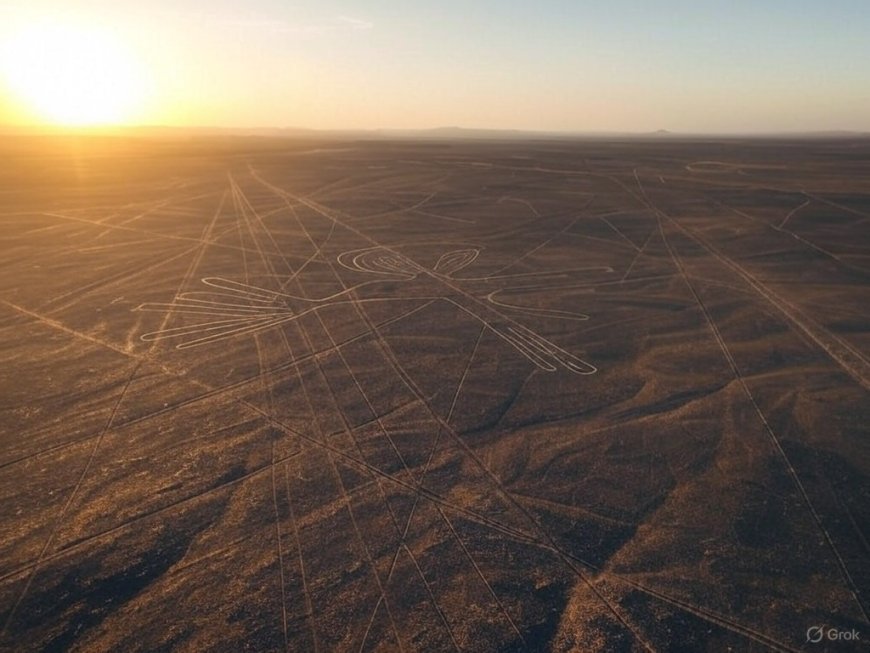The Nazca Lines: An Ancient Astronomical Calendar or an Unsolved Mystery?
Are the Nazca Lines an ancient astronomical calendar? Explore the mystery behind these massive geoglyphs and their possible link to celestial events.

Introduction
Deep in the arid plains of southern Peru, the Nazca Lines stretch across the desert landscape, forming massive geometric shapes, intricate patterns, and depictions of animals and humans. These massive geoglyphs, etched into the ground over 2,000 years ago, have fascinated archaeologists, historians, and conspiracy theorists alike. While some believe they were created for ritualistic or religious purposes, others argue that they functioned as an astronomical calendar. But could the Nazca people have really designed these formations to align with celestial events?
What Are the Nazca Lines?
The Nazca Lines are a collection of over 800 straight lines, 300 geometric figures, and 70 depictions of animals and plants (also called biomorphs). They were created by removing the reddish-brown iron-oxide-coated pebbles from the desert floor, exposing the lighter-colored earth beneath.
Discovered in the 1920s when commercial flights over Peru revealed their massive scale, the lines range from simple straight paths to elaborate images stretching up to 1,200 feet (370 meters) long. Despite centuries of exposure, the dry, windless climate of the Nazca Desert has helped preserve these formations.
Who Created the Nazca Lines?
The lines are believed to have been created by the Nazca civilization, which flourished between 200 BCE and 600 CE. This culture, known for its advanced irrigation systems, pottery, and textiles, left no written records explaining the purpose of the lines, leaving room for speculation.
Astronomical Calendar Theory: Did the Nazca People Map the Stars?
One of the most compelling theories about the Nazca Lines is that they served as an astronomical calendar for tracking celestial movements. This idea was popularized by Maria Reiche, a German mathematician and archaeologist, who spent decades studying the geoglyphs.
Reiche proposed that many of the lines correspond to the positions of the sun, moon, and various stars during solstices and equinoxes. She suggested that the Nazca people, who relied heavily on agriculture, may have used these lines to track seasonal changes and predict rainfall—a crucial factor in a desert region with minimal water sources.
Evidence Supporting the Astronomical Theory
-
Celestial Alignments
Some lines appear to align with important astronomical events, such as the rising and setting of the sun during the solstices. This suggests a possible link to agricultural cycles, allowing the Nazca civilization to time their planting and harvesting seasons. -
Connection to the Pleiades Star Cluster
Studies indicate that some of the lines may have been directed toward the Pleiades, a cluster of stars that was important to many ancient civilizations, including the Inca. This suggests that the Nazca people may have incorporated star movements into their belief system and daily life. -
Similarities to Other Ancient Astronomical Structures
Other ancient cultures have demonstrated the use of large-scale structures to align with celestial bodies. For example:- Stonehenge in England was used to mark the solstices.
- Mayan temples were built to align with planetary cycles.
- Egyptian pyramids were constructed with precise astronomical orientations.
This raises the possibility that the Nazca civilization may have had a similar understanding of the cosmos.
Alternative Theories: Religious, Ritualistic, or Extraterrestrial?
While the astronomical calendar theory is widely accepted, other interpretations challenge this idea.
1. Religious and Ritualistic Use
Some archaeologists argue that the Nazca Lines were created for religious ceremonies or ritualistic purposes. The Nazca people may have walked along the lines as part of spiritual practices aimed at invoking deities for rain and agricultural prosperity.
2. Water Worship and Rituals
Another theory suggests that the lines were connected to water worship. Some geoglyphs resemble natural water sources or irrigation channels, leading scholars to speculate that they played a role in ceremonies dedicated to Tlaloc, the water god.
3. Extraterrestrial Theories
Due to the sheer size and precision of the geoglyphs, some believe that the Nazca people either received guidance from extraterrestrials or created the lines as landing sites for alien visitors. While there is no scientific evidence to support this claim, it remains a popular topic in speculative history and UFO theories.
Recent Scientific Studies and Discoveries
Modern technology, including satellite imagery, LiDAR scanning, and AI mapping, has allowed researchers to discover even more geoglyphs, some of which were previously invisible to the naked eye. A recent study published by National Geographic found over 140 new geoglyphs using artificial intelligence, expanding our knowledge of the Nazca civilization’s artistic and cultural expressions.
Additionally, research published in Science Direct has explored the soil composition of the lines, revealing how the Nazca people engineered their designs to withstand erosion over centuries.
Could the Nazca Lines Be a True Astronomical Calendar?
While there is strong evidence linking some of the Nazca Lines to astronomical events, the full purpose of the geoglyphs remains unknown. The lack of written records means that we may never fully understand their intended use. However, their alignment with celestial patterns, combined with the importance of astronomy in other ancient cultures, suggests that the lines likely had a dual purpose—both ritualistic and astronomical.
Ongoing Research and Preservation Efforts
Due to climate change and increasing human activity, some of the Nazca Lines are at risk of damage. Organizations like UNESCO and Peruvian authorities are working to protect and study these ancient marvels, ensuring they remain preserved for future generations.
Final Thoughts
The Nazca Lines continue to captivate the world, blending history, astronomy, and mystery into one of the greatest unsolved puzzles of our time. Whether they functioned as an astronomical calendar, a spiritual guide, or something beyond our current understanding, their precision and scale showcase the ingenuity of the Nazca civilization.
As research advances, new discoveries may provide further insight into these incredible geoglyphs, but for now, they remain one of the most intriguing ancient mysteries on Earth.
For further reading on ancient astronomical structures, visit Smithsonian Magazine.
What's Your Reaction?
 Like
0
Like
0
 Dislike
0
Dislike
0
 Love
0
Love
0
 Funny
0
Funny
0
 Angry
0
Angry
0
 Sad
0
Sad
0
 Wow
0
Wow
0



















































